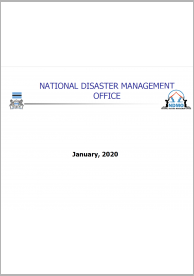The most common natural hazards in Botswana are floods and droughts, affecting on average more than 5 million and 845 million people annually, respectively (UNDRR and CIMA, 2019). In addition, in recent years the country has been affected by new threats, such as the Tropical Cyclone Dineo, in 2017, and other extreme weather events like heatwaves and earthquakes (UNISDR, 2019). Botswana is aware of its vulnerability, having a well-established legal framework, concerning DRR and management.
The National Disaster Management Office (NDMO) is the institutional body responsible for coordinating and ensuring the effective implementation of DRR. The NDMO accomplishes its mission through the National Committee on Disaster Management (NCDM), the National Disaster Management Technical Committee (NDMTC) and the District Disaster Management Committee (DDMC), and at Village level, through the Village Development Committees (VDC).
There is a National Committee on Climate Change and a national vision is provided by the National Climate Change Strategy for Botswana and the National Climate Change Action Plan for Botswana (2018). Climate change is also addressed in a combination of different policy areas, with a common focus on sustainable growth and specific climate adaptation and mitigation policies already in place in some sectors.
UNDRR and CIMA (2019). Botswana Disaster Risk Profile.
- UNISDR (2019). Global Platform for Disaster Risk Reduction - Speeches and Statements. Retrieved from https://www.unisdr.org/conference/2019/globalplatform/programme/official-statements
In Botswana, a Southern African country occupied by a plateau that has an average altitude of around 1,000 meters, the climate is sub-tropical, arid or semi-arid depending on area. The winter, from May to August, is dry and sunny, mild during the day but cold at night, especially in the center and south. The summer, from November to March, is hot and moderately rainy because of thunderstorms that break out in the afternoon or evening; therefore, there's plenty of sunshine even in this season, especially in the morning. In spring, in September and October, the heat is often intense especially in the north, however, hot days are possible throughout the country from September to April.
The driest areas are the south-west, where the Kalahari desert is found and precipitation drops below 300 millimeters per year, and the far east, in the valley of the Limpopo, where it goes below 400 mm per year. The wettest areas, where more than 500 mm of rain fall per year, are the north and the south-east, where Gaborone is located. In general, rainfall in the warm season is not very abundant, but during some years, it can be more abundant than usual, when the country is reached by moist air masses from Congo, or because of the remains of cyclones.
The average daily temperature of the coldest months, June and July, is around 11/12°C in the south and 18°C in the north; already in August, the temperature starts to increase. In summer, the temperatures are more uniform across the country, in fact, they range between 25°C and 27°C, depending on latitude and on altitude. The hottest months are December and January in the center-south, while in the north, the hottest days occur in October and November, before the rains that are able to lower the temperature a bit: in this period, the daytime temperature is normally around 35°C, but can even reach 40°C.

Regional Platform / DRR Contact Point
-
Government of BotswanaOrganization type:
Risk reduction Policies, Plans & Strategies
Policies, plans and official statements on disaster risk, climate adaptation and resilience.
| Test Document Test Document Summary | |

|
Speech by honourable Ronald Machana Shamukini -Resilience divided: Towards sustainable and inclusive societies
Speech by honourable Ronald Machana Shamukini Assistant Minister for Presidential Affairs, Governance and Public Administration on the occasion of the Sixth Global Platform for Disaster Risk Reduction 2019 (Geneva, Switzerland; 13-17 May, 2019). |

|
Botswana National Climate Change Action Plan 2018
This action plan serves as a companion document to the Botswana National Climate Change Strategy of 2018. It provides a clear pathway for the implementation and monitoring of the strategy by providing targets and indicators for each strategy. |
Documents & Publications
Disaster risk reduction and resilience publications, reports, research papers and case studies.

|
Botswana Disaster Risk Reduction Baseline
Botswana presentation in the Strengthening Disaster Risk Reduction, Coordination, Planning and Policy Advisory Capacity of SADC Project Inception Workshop, held in Johannesburg, South Africa, 20-24 January 2020. |

|
RIASCO Humanitarian Outlook for Southern Africa | November 2017-April 2018
This report analyses some of the southern african countries readiness to humanitarian impacts related to their macro-economic conditions, the regional seasonal rainfall forecast, the food, livelihood and nutrition security and the conflict in Democratic Republic of Congo. |

|
Spaces of vulnerability and areas prone to natural disaster and crisis in six SADC countries: Disaster risks and disaster risk management capacity in Botswana, Malawi, Mozambique, South Africa, Zambia and Zimbabwe
In light of national, cross-border, transboundary and regional hazards of various type in Southern Africa, a desk review was undertaken by the International Organization for Migration (IOM) in order to enhance the understanding of disaster risk and spaces of vulnerability (i.e. |
Disaster Data & Statistics
Reports on disaster statistics, country profiles and additional resources on collecting disaster loss data.

|
Document Title to test workflow Lorem Ipsum is simply dummy text of the printing and typesetting industry. Lorem Ipsum has been the industry's standard dummy text ever since the 1500s, when an unknown printer took a galley of type and scrambled it to make a type specimen book. |

|
Disaster Risk Profile - Botswana
The Country Risk Profiles provide a comprehensive view of hazard, risk and uncertainties for floods and droughts in a changing climate, with projections for the period 2050-2100. The risk assessment considers a large number of possible scenarios, their likelihood, and associated impacts. |

|
INFORM Country Risk Profile - Botswana
Index for Risk Management. |

